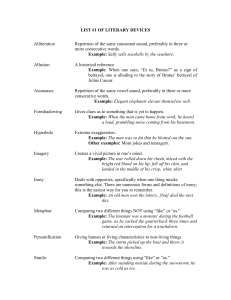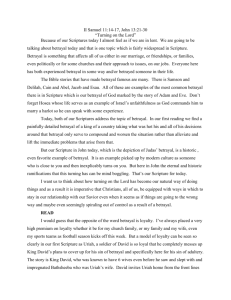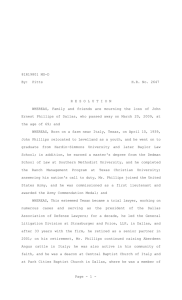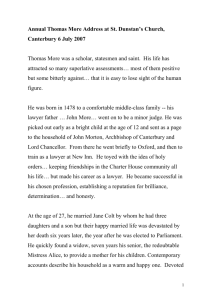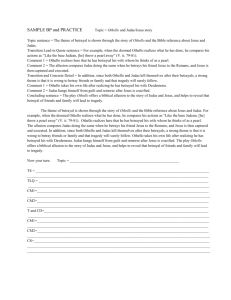Betrayers and Betrayal in the Age of William Tyndale
advertisement
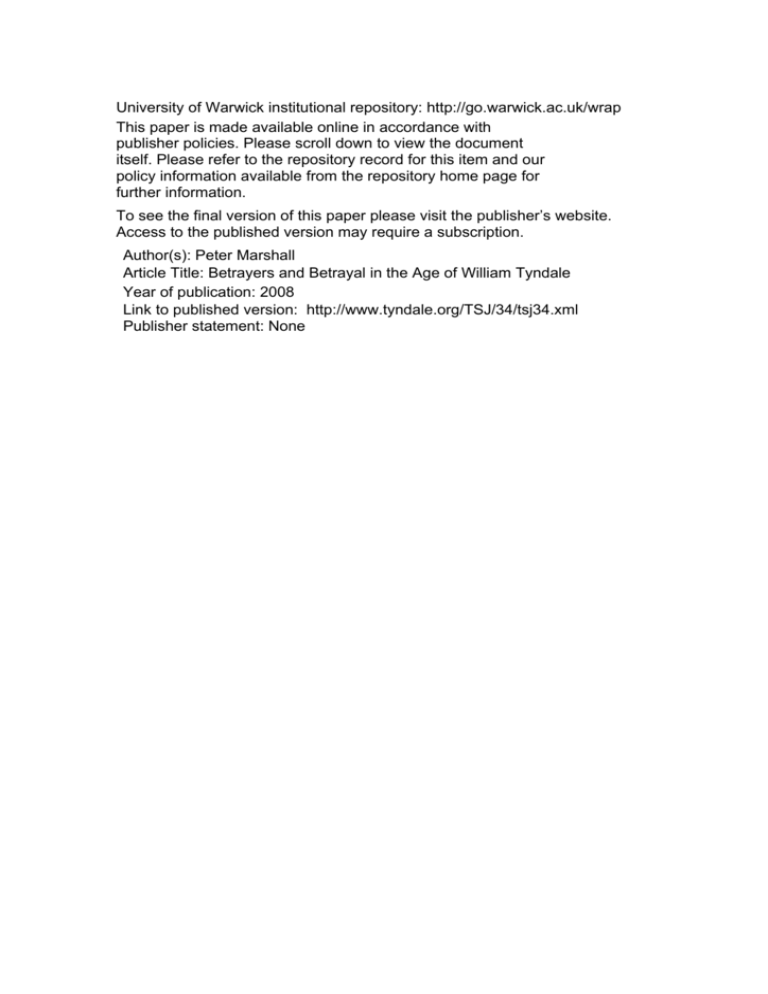
University of Warwick institutional repository: http://go.warwick.ac.uk/wrap This paper is made available online in accordance with publisher policies. Please scroll down to view the document itself. Please refer to the repository record for this item and our policy information available from the repository home page for further information. To see the final version of this paper please visit the publisher’s website. Access to the published version may require a subscription. Author(s): Peter Marshall Article Title: Betrayers and Betrayal in the Age of William Tyndale Year of publication: 2008 Link to published version: http://www.tyndale.org/TSJ/34/tsj34.xml Publisher statement: None Betrayers and Betrayal in the Age of William Tyndale Of the great stock of moral transgressions of which human beings are capable, betrayal has always been conspicuously difficult to forgive. In a betrayal there must always be an injured party; it is never a victimless crime. Nor can it be excused as a crime of passion, of a sudden angry loss of control. Betrayal involves calculation, forethought, a conscious decision to do harm or allow harm to be done. Worst of all, an almost necessary condition of betrayal is a prior relationship of intimacy. One can hardly betray a total stranger. The pain of this realisation is nowhere better expressed than in that great catalogue of grievance and lament, the Book of Psalms. In Psalm 55, verses 12-14 in the Authorized Version, the psalmist reflects that if it had been ‘an enemy that reproached me; then I could have borne it: neither was it he that hated me that did magnify himself against me; then I would have hid myself from him: But it was thou, a man mine equal, my guide, and mine acquaintance. We took sweet counsel together, and walked unto the house of God in company.’ In the history of the Christian West, the principal symbol of the betrayer is, of course, the kiss. For Christians, it is a striking paradox, and sometimes an uncomfortable one, that an act of betrayal should have been the trigger, or even the essential precondition, for the salvation of mankind: Judas Iscariot is a pivotal figure of the Christian story. For believers in the late middle ages, Judas’s betrayal was inextricably linked, not only with the crucifixion and death of Jesus, but with the central act of ritual Christian memory, the Eucharist. St Luke’s account of the Last Supper (22:21) tells us that Christ, immediately after the words of consecration, announced ‘behold, the hand of him that betrayeth me is with me on the table’. The popular late medieval text, The Lay Folks Mass Book, brought home to its readers the reality of transubstantiation by urging them to remember that the host they saw elevated during the mass was none other than ‘he that Iudas salde’. 1 The potential ambivalence of the gesture of the kiss was also recognised in the liturgy. The kiss of peace, in the form of venerating a metal pax or pax-bread, preceded the communion at every mass as a token of collective goodwill and charity. But once a year the ritual was laid aside. In his sermon for Maundy Thursday, the pre-reformation homilist John Mirk advised priests to explain to their people that ‘this day is no paxe gyuen at the masse / for Iudas betrayed Cryst this nyght with a kysse.’ 2 Early Tudor parishioners, like the young William Tyndale, who grew up in this culture, must have had an instinctive horror of the betrayer. But before the revolution initiated by Martin Luther began to divide their world, how many could have imagined having to experience such betrayals in their own lives? Tyndale himself, of course, was a man betrayed, and betrayed unto death. As is well known, his nemesis was a young and profligate Englishman, Henry Phillips, who inveigled himself into the society of English merchants at Antwerp among whom Tyndale had taken refuge. According to John Foxe, our key authority for this episode, Phillips pretended friendship and interest in Tyndale’s writings, soon persuading the reformer that he was ‘an honest man, hansomly learned, and very conformable’. In the meantime, Philips had alerted the imperial authorities in Brussels that he could deliver them a notorious heretic. Choosing his moment, Phillips lured Tyndale from the English house on the pretext of an invitation to dinner, having first borrowed from him the sum of 40 shillings. Waiting in the narrow alley outside were imperial officers, who upon a signal from Phillips seized Tyndale. He was removed to the castle of Vilvorde, where sixteenth months later, he was burned at the stake. 3 2 We will probably never know the full circumstances lying behind this murky episode. It is unlikely that Phillips’s operation was entirely freelance. Only a few years later the chronicler Edward Hall was asserting that it took place ‘not without the help and procurement of some of the bishops of the realm’. 4 The conservative bishop of London, John Stokesley, is usually seen as the most likely instigator. 5 Yet it is Phillips himself, rather than his shadowy paymasters, who has born the brunt of posterity’s indignation. Foxe condemned him as ‘that traytour worse then Iudas’, and the voice of modern scholarship has scarcely been kinder. A. G. Dickens called him ‘the squalid betrayer Henry Phillips’, and to Tyndale’s most recent scholarly biographer, David Daniell, he appears as an ‘evil betrayer’, a mixture of ‘malice, selfpity, villainy and deceit’, ‘almost psychopathic’. 6 I have no desire to vindicate or exonerate Henry Phillips. What I would like to do, however, is attempt to place his actions in a wider cultural context; to take a broader look at how religious and political betrayal was perceived and experienced in the couple of decades either side of William Tyndale’s death. My argument is that it is possible to detect an insistent concern with the theme of betrayal, beating like a quickening pulse through the early decades of the English Reformation. The appearance and widening of religious divisions, coupled with the attempt by political and ecclesiastical authorities to control behaviour and bind consciences, together created the condition for betrayal to be enacted, and for fears about it to grow. Yet we need to recognise at the outset that the pejorative term ‘betrayal’ is an interpretation of an event, not a neutral description of it. The suggestion that Henry Phillips should be seen as a principled defender of the Old Faith, bravely adopting a false persona in order to help arrest the growth of egregious heresy, might well make us feel uncomfortable. Yet that, just perhaps, is how he represented his actions to himself. Most of us would probably feel equally uncomfortable about applying the label ‘betrayer’ to the undercover British army officers who infiltrated the IRA in the 1970s, or to those Muslims who today are doubtless feigning support for extremist Islamist groups in order to report on them to Western intelligence agencies. Betrayal is in the eye of the beholder. Let us stay with Henry Phillips just a little longer, for his fate and fortunes after the betrayal of 1535 illustrate some of the complexities of our theme. In the years after Tyndale’s arrest, he was a marked man – his movements across Europe were persistently tracked by the English government and its agents on the ground, and repeated though unsuccessful efforts were made to have him extradited and returned to England. This was not principally in revenge for Tyndale, about whose fate Henry VIII cared very little. Phillips was guilty of a much greater betrayal. In the words of the attainder act of 1539, which indicted a host of Henry’s enemies, at home and overseas, Henry Phillips had with others ‘maliciously and traitorously named and promulg[at]ed that venomous serpent the Bishop of Rome to be Supreame head of the Church of this… Realme of England’. 7 Betrayal of the obligation of obedience towards the king was a crime of crimes, and all measures were appropriate in pursuing those who had committed it. The world of English religious exiles on the continent - in the Low Countries, France and Italy- around which Henry Phillips moved, was one of agents and double-agents, in which it was never possible to know completely whom to trust. When Phillips attempted to enter the service of the figurehead of English Catholic resistance, Cardinal Reginald Pole, at Padua in 1538, he was rebuffed. Pole and his entourage suspected him of being an assassin, or at least a spy for Cromwell, and caused him to be banned from Venetian territory. Yet the government heard this story only because of another betrayal of trust: Pole’s right- 3 hand man, Michael Throckmorton, confided in a travelling Englishman, Thomas Theobald, who was sending back detailed reports to Cromwell and Archbishop Cranmer. Theobald scoffed at the edginess of the Catholic exiles: ‘every wagyng of a strawe makethe them nowe afrayd.’ 8 The exiles were right to be cautious, for betrayal of their plans was in government eyes no infidelity but a laudable and patriotic duty. Phillips himself was the victim of several such breaches of trust. In May 1537, the English ambassador in Brussels, John Hutton, was approached by a penurious exile named Vaughan, who revealed to him a scheme whereby Phillips was planning to convey treasonable letters to Cardinal Pole’s contacts in England, baked in loaves of bread. Hutton urged him to encourage the enterprise, and gave him 40s. ‘He is to inform me secretly of everything while he is here, and on landing cause them to be attached.’ 9 Vaughan evidently had second thoughts, for later in the year Phillips wrote to Hutton reproaching him with giving Vaughan ‘a commission that went against his conscience.’ Instead of luring Phillips into the trap, the Welshman had warned him of the snares being set for him. 10 Thomas Theobald boasted to Cromwell in 1538 that he had earlier ‘insinuated himself into familiar acquaintance with Phillips to know what practice he went about with Tyndale’, and in early 1540, another English ambassador, Thomas Wyatt, was pleased to report to Cromwell that his agent John Tor ‘insinuates himself very well’ with the exiled traitors Phillips and Robert Brancetour. 11 All the schemes to secure Phillips came to nothing. The last sighting of him is in August 1542, on Christian Europe’s eastern frontier. Sir Thomas Seymour, Henry’s ambassador to Ferdinand, King of the Romans, wrote from Budapest that Phillips and another English traitor had recently arrived in Vienna, intending to take service against the Turk. Seymour eventually identified this second traitor as Brancetour, but not before he had mistakenly identified him to London as a Welsh exile named James ap Gruffydd ap Hywel. 12 The mistake was understandable. Phillips and James ap Gruffydd had known each other in Flanders in 1535; had travelled through Germany together in 1536, with government agents in hot pursuit; and had both approached Pole in Italy in 1538. James too was an enemy of the King’s proceedings, and one who had left behind him a reputation for betrayal. He was a minor gentleman from Pembrokeshire, and a retainer and kinsman of the local magnate, Rhys ap Gruffydd. Rhys had come spectacularly to grief in 1531, when his feuding in South Wales, coupled with his known opposition to the Boleyn marriage, led to his arrest and execution on charges of treason. The indictment alleged that he had discussed treasonable prophecies with his servants, and was planning to plot with the king of Scots against Henry’s throne. Three of his followers were indicted with him, but one of these, James, was released after turning King’s evidence against his master and providing the details that led him to the block. A century later, Rhys’s descendents had not forgiven the treachery, remembering James as ‘a man of mean estate’, who had brought false witness against Rhys and was later ‘sore troubled’ in his conscience. In this last assessment they were perhaps right, for within a year of his release from the Tower in 1532, James had fled to Ireland; thence to Scotland and the Low Countries, and in each place trumpeted himself as a champion of Queen Katherine and a victim of the heretical malice of Henry VIII. As with Phillips, the English authorities never managed to catch up with James ap Gruffydd, but it was not for want of offers and opportunities. On at least three occasions, members of James’s retinue, weary of the life of an exile, contacted English ambassadors and agents with offers to betray him. 13 4 From the world of the exiles, let us turn attention to the situation at home. Holders of unorthodox opinions in England had always had to keep one eye over their shoulder. But with the arrival of Luther’s ideas in the 1520s, the stakes were raised considerably. The first generation of English evangelicals had to be on guard, not merely against Catholics casually scandalised by their opinions, but against those actively on the look-out for heretics to denounce. The actions of one such agent provocateur brought about the execution of John Frith in 1533. Imprisoned in the Tower for his heretical views on purgatory, Frith turned his pen to the still more dangerous topic of the real presence of Christ in the sacrament, sending a manuscript treatise to a well-wisher in the city. This sympathiser was acquainted with a tailor named William Holt, a man who, in the words of Hall, ‘outwardely professed muche honestye, but inwardly was a verye spye and a verye betrayer’. He was probably in fact part of network of informers maintained by Thomas More as Lord Chancellor. Holt begged Frith for a copy of the treatise, and immediately sent it to More. Though now retired as Chancellor, More composed a reply, which Holt delivered to Frith in prison, provoking another response. Frith’s refusal to recant his by now well-known sacramentarian views led to his burning at Smithfield. With him perished another sacramentarian, a young tailor’s apprentice, Andrew Hewett, who, according to Hall, ‘was also betrayed by the foresayd Holt’. 14 By the mid-1530s, it was not only evangelicals who were in danger from those they thought they could trust. After the break with Rome, letters began to arrive on Thomas Cromwell’s desk from all parts of the realm, with details of disloyal speeches and seditious words, the amateur denunciations of neighbours and parishioners, motivated by loyalty to the king, desire for vengeance, or hope of reward. Several were generated by encounters supposed to be sealed by mutual trust and utter secrecy, those of priest and penitent in confession. A string of lay people in these years denounced ‘ghostly fathers’ for upholding the old ways and exalting the authority of the pope. Some ‘penitents’ seem to have gone to confession with the precise aim of eliciting and then reporting such views. 15 Of all the religious conservatives who fell foul of an agent provocateur in the 1530s, one name stands out, that of Thomas More. There is an uncanny symmetry in the fact that Tyndale and More, bitterest of enemies, and standard-bearers for their respective causes, should both have been betrayed within a matter of weeks by men who today are largely remembered for that one deed. More may have trusted Rich less than Tyndale trusted Phillips, but he had known him longer, indeed from his youth, ‘for we long dwelled both in one parish together.’ 16 The putative betrayal, however, came after, rather than before More’s arrest. The official indictment claimed that during a visit to the Tower on 12 June 1535 to confiscate More’s books, Rich held a conversation with him about real and hypothetical powers of statute, in the course of which More denied parliament any authority to make the king Supreme Head of the Church. Modern scholars disagree over whether More actually said the alleged words, but it was undoubtedly Rich’s testimony at the trial that secured the treason conviction. All of More’s sixteenth-century biographers agree that Rich came to him in the Tower, ‘pretending friendly talk’, though really ‘with the intention of finding matter for accusation’.. 17 A similar strategy may have been used against More’s fellow martyr, Bishop John Fisher. According to fragments extracted from William Rastell’s lost life of More, the king needed clearer evidence of Fisher’s rejection of the royal supremacy, and so despatched ‘one of his suttle consellours’ with a secret message to the bishop in the Tower, stating that Henry, for reasons of his own conscience, desired to know 5 Fisher’s true opinion of the supremacy, and that no harm would come to him by declaring it. But Fisher’s words were later used against him in court, the messenger shamelessly avowing that any supposed promises of immunity ‘do not discharge you any whyte.’ 18 A sixteenth-century life of Bishop Fisher identified this secret and treacherous messenger as Richard Rich. 19 There are problems with these accounts, and it is conceivable that Rich’s name was attached because of his connection with the condemnation of More. But it is not inconceivable, or even intrinsically unlikely, that Rich was called upon to play the same dissembling part in securing the conviction of both men. In contrast to Henry Phillips, ideological conviction seems to have played no part in Rich’s calculations. Throughout his career, he showed an unerring ability to accommodate himself to the prevailing winds. He went on to become Chancellor of the Court of Augmentations, and a Privy Councillor. In 1540, his evidence helped to secure the conviction of his erstwhile patron Thomas Cromwell on fabricated charges of heresy and treason, and in Edward’s reign he rapidly abandoned allegiance to Lord Protector Somerset when circumstances dictated it. Under Mary, he changed his colours again, and participated in the drive against heresy. He was a man who made a career out of betrayal. 20 It is noteworthy, and perhaps surprising, that none of the early biographers of Thomas More compared Richard Rich to Judas. This reticence might be explained by the fact that when Roper and Harpsfield were writing, towards the end of Mary’s reign, Rich was again a leading figure in government. Yet well before this, writers on all sides had developed the habit of likening their opponents to the betrayer of Christ. Thomas More himself saw the difference between ‘catholyke folke and the false heretykes’ as being no less than ‘betwene false Iudas and Crystes faythfull apostles’. 21 Tyndale was more than ready to return the compliment, characterising the prelates serving the pope as ‘Judases enough, that would forsake Christ and betray the truth’. 22 There was more going on here than mere mudslinging. As religious divisions hardened, beleaguered English Christians, and particularly evangelicals, began to identify the scriptural patterns giving shape to their own experiences of opposition and adversity. For those conscious of unfaithful dealing, Psalm 55 offered expression to the painful awareness of betrayal. Several paraphrases and free translations of the text were undertaken by prisoners in the Tower of London, including the earl of Surrey in 1546, Sir Thomas Smith in 1549-50, and the young earl of Warwick in 1554, each bringing into their version a sharp sense of betrayal at the hands of friends and erstwhile political allies 23 The bitter taste of betrayal was no prerogative of the high and mighty. It was surely of Psalm 55 that the humble Sussex Protestant, Richard Woodman, was thinking when he wrote to an acquaintance from prison after his condemnation in 1557: ‘yea and euen them that eate of my breade, that should haue bene moste my frends by nature, hath betrayed me’. 24 The experience and representation of persecution and martyrdom brought the figure of Judas firmly to the forefront of religious consciousness in these years. After his arrest, Woodman told his captors that ‘this way was appointed of God for me to be deliuered into the handes of mine enemies’, and went on to add, in conscious imitation of Christ’s words (Matt. 26:24), ‘woe vnto hym by whom I am betrayed. It had ben good for that man, that he had neuer bene borne’. 25 For English Protestants, the persecution of Mary’s reign brought home the threat and reality of betrayal in its most insidious forms. Of the nearly 300 English men and women who died for their beliefs between 1555 and 1558, many suffered as 6 a result of denunciations by neighbours and kin. The pages of Foxe’s Acts and Monuments are full of references to village and small town Judases, motivated by profit or spite. 26 Often the gloss is Foxe’s own, but at other times the role of Judas was clearly discerned by the actors involved. After the London pastor John Rough and his underground congregation were informed on to Bishop Bonner in 1558 by a tailor named Roger Sergeant, Margaret Meering took it upon herself to go to his house, asking ‘whether Iudas dwelte not there or no.’ 27 In 1557, Helen Ewring was one of 22 Protestant prisoners sent from Colchester to London, and also one of the number released and sent home to Essex. Upon her return, she met with the town bailiff, Robert Maynard, ‘who spieng her went and kist her, and bad her welcom home’. But Ewring knew he that was an enemy to the truth, and retorted ‘that it was but a Iudas kisse. for in the ende…I knowe ye wil betray me’. So it turned out, and he shortly afterwards ordered her arrest. 28 Yet it was for Henry Phillips that Foxe himself developed the connection with Judas most resolutely, drawing comparison, for example, between the bag containing the apostles’ funds, which Judas ran off with when he went to betray Christ, and the bag into which Phillips put the money he borrowed from Tyndale that fateful day in 1535. In his second edition of 1570, Foxe extended the parallel to the respective fates of the traitors. Just as Judas went off to hang himself, ‘the saying so goeth, that [Phillips] not long tyme after enioyed the price of innocent bloud, but was consumed at last with lyce.’ 29 Referencing of Judas allowed two understandings of betrayal, a social and a theological one, to become closely fused together. The bishops who condemned the Marian martyrs to the flames were also, by definition, betrayers of Christ. After the burning of John Philpott in 1555, a sympathiser wrote to Bonner asserting ‘that good mans reward in heauen’, and threatening damnation if the bishop did not cease shedding innocent blood. ‘But it is to be feared your hart is hardned as Pharaoes was, seyng that with Iudas ye haue sold and betraied your maister.’ 30 Yet Judas was not a Pharisee, or an officer of the occupying Roman forces; he was one of the twelve, a close disciple of Jesus. Evangelicals could expect to find Judases, not only among the adherents of the persecuting Catholic bishops, but in their own ranks. The most insidious betrayals involved, not an opportunistic taking of the enemy’s silver, but a renunciation of the cause of Christ himself, often under intense psychological pressure. Naturally, it was the aim of the Henrician and Marian authorities to get accused heretics publicly to abjure their erroneous opinions, and return to orthodox faith. In the eyes of the persecutors, a recantation represented a soul saved from the disease of heresy; a burning was an opportunity lost. Susan Wabuda and Alec Ryrie have shown how some early Tudor evangelicals were adept at strategies of survival, and could find ways of casuistically subverting the statements they were required to read in public. 31 But in the last years of Henry VIII’s reign, attitudes towards recantation within evangelical circles were hardening. John Bale’s judgement on the recantation of William Tolwin in 1541 was that, having been ‘a dere chylde of Christ, he is made a sworne chylde of the devyll’. 32 When the former evangelical bishop of Salisbury, Nicholas Shaxton, tried to persuade Anne Askew to recant like he had on the eve of her execution in 1546, she turned on him the chilling words of Jesus about his own betrayer: ‘that it had bene good for hym, never to have bene borne’. 33 Defections were always difficult to accept and sometimes difficult to belief. When rumours reached Nicholas Ridley in prison that his protégé, Nicholas Grimald, might have become an informer for the Marian authorities, he confessed that ‘it will 7 not sink into my head to think that Grimbold would ever play me such a Judas’s part’. But eventually he accepted that Grimald must have bowed his ‘knee unto Baal.’ 34 The decision whether or not to do so was one faced in Mary’s reign not only by the highprofile Protestant clergy, but by all of the rank-and-file. Was mere attendance at mass tantamount to a betrayal of Christ, a Judas-like action? Some authorities insisted it was. John Philpott wrote to the faithful from prison in 1556 about the need to absent oneself from this ‘prophanation of the Sacrament of the body and bloud of Christ’. Some people foolishly thought that the presence of the body was immaterial, so long as the heart did not consent, but they should understand that their actions undermined the faith of weaker brethren, and that they were ‘traytors to the truth, like vnto Iudas, who with a kisse betraied Christ.’ 35 Nicodemism, the performance of outward conformity while remaining faithful to one’s convictions at heart, was widely practised throughout the Reformation era, by Catholics and Protestants alike. 36 But this was not always the path of least resistance. For some at least, the price was an internalisation of the drama of betrayal, a sense of self-accusation or self-loathing; sometimes even a self-identification with the figure of Judas. There are numerous examples in Foxe of Protestants initially conforming to the Catholic restoration, and later, in a conscience-striken state, publicly repudiating their conformity in a way virtually guaranteed to bring them to the stake. 37 James Abbes, a young Suffolk labourer, was arrested and brought before the Bishop of Norwich, John Hopton, in August 1555. Worn down ‘both with threates and faire speache’, Abbes recanted, and in recognition of his poverty, Hopton sent him on his way with an almspayment of 40d. But before long, stricken with remorse, he returned to the bishop, throwing the money at his feet - a gesture designed to recall Judas’s return of his silver pieces to the high priests. Foxe’s judgement was that though Abbes ‘had plaid Peter before through infirmitie… [he] stoode manfully in hys masters quarel to the ende.’ 38 This distinction between the betrayal of Christ by Peter, and that by Judas, could be a lifeline to the conscience. Foxe also reports the case of a priest from Canterbury, who in the first year of Mary’s reign ‘sayd Masse on the one day, and the next day after he came into the pulpyt and desired all the people to forgiue hym, for he sayd he had betrayd Christ, but not as Iudas dyd, but as Peter’. 39 There was considerably more at stake in the comparison between Peter and Judas than a smart piece of casuistry, or a bold rhetorical flourish. For the juxtaposition stood at the heart of contemporary doctrinal debates about the nature of penance and repentance. All agreed that the repentance Judas displayed - the admission he had betrayed innocent blood, and his return of the 30 pieces of silver had been inadequate to secure forgiveness. To traditionalists, this was because he had not shown himself sufficiently contrite. The evangelical view, by contrast, was that Judas’s repentance was flawed precisely because it so closely resembled the traditional Catholic understanding of the sacrament. According to John Bradford, Judas was an exemplar of all three constituent parts of Catholic penance – contrition, confession, satisfaction – a point subsequently elaborated in the official Elizabethan homily on repentance of 1563. The stain of treachery was thus discovered at the heart of the sacramental system; its perilousness, asserted Bradford, was exposed by ‘the example of their grandsire Judas’. 40 The point was not lost on ordinary Protestants. The London martyr, Robert Smith, boldly asserted at his examination in 1555 that ‘if ye confesse you to the Priest, and not vnto God, ye shal haue the reward that Iudas had: for he confessed hym selfe to the priest, and yet went and hanged hym selfe’. 41 The ability of Judas to frame and focus doctrinal division was similarly evident in a still more pivotal issue. Whether Judas had been present at the Last 8 Supper, and of what he received if he had been, were not trivial or abstruse questions, but a central means of establishing and defending rival understandings of eucharistic community, and the nature of sacramental action. Catholics committed to an ex opere operato view of the sacraments insisted that the consecrated bread and wine offered to Judas at this first mass were in every way identical to what the other disciples received, albeit his unworthiness meant he was, in a Pauline phrase, eating and drinking his own damnation. The alternative was a receptionist view, which transferred the aperture of divine grace from the sacramental action of the priest to the spiritual disposition of the communicant. For both Catholics and Protestants, therefore, asking whether Judas received the body of Christ could become a test of eucharistic orthodoxy, and the issue was brought up at several Marian heresy trials, sometimes by the accusers and sometimes by the accused themselves. 42 Protestant theologians like Bradford and Nicholas Ridley were also able to make the most of a distinction originating with St Augustine, that Judas received only panem domini, whereas the other disciples were given panem dominum - the bread of the Lord, but not the Lord as bread. 43 We have arrived by a circuitous route at a curious place: a discovery of the extent to which, by the middle of the sixteenth century, Judas had become the arbiter of doctrinal dispute for English Christians, and a key figure in the process of sharpening awareness of religious difference that historians call ‘confessionalization’. This was a remarkable development. The Judas of the later middle ages was the ultimate outsider and outcast, the distorted reflection of a fundamentally united Christian community. As a suicide, he exemplified the crime that put its perpetrators beyond hope of salvation. In art and literature, his avarice was conflated with antisemitic stereotypes about all Jews, for whom Judas served as a negatively representative type. 44 Popular medieval sermon collections like the Golden Legend and Mirk’s Festiall told remarkable stories about him. He was a foundling set adrift at sea after his parents’ prophetic dream of his wickedness; he later slew his father and committed incest with his mother; he became a servant, like finding like, in the household of Pilate. 45 But the Judas of the Reformation age was no longer a grotesque stranger. He had become uncannily familiar, a figure to be looked for in the midst of faithful Christians, and in believers’ own hearts. Betrayers and betrayal were a functional consequence of the processes making up the English Reformation; they were also, for good, and more often ill, a formative influence on its development. . 1 T. F. Simmons, The Lay Folks Mass Book, E[arly] E[nglish] T[ext] S[ociety], os 71 (1879), 38. John Mirk, The festyuall, (London, 1508), fol. 31v. 3 John Foxe, Actes and Monuments [hereafter, Foxe] (London, 1563), 519-20. 4 J. F. Mozley, William Tyndale (London, 1937), 300. 5 Ibid.; D. Daniell, William Tyndale: A Biography (New Haven and London, 1994), 368. There is no convincing evidence for Brian Moynahan’s claim that Thomas More masterminded the operation from his cell in the Tower: If God Spare my Life: William Tyndale, the English Bible and Sir Thomas More (London, 2002), 332-54. 6 Foxe (1563), 523; A. G. Dickens, The English Reformation (2nd ed., London, 1989), 95; Daniell, Tyndale, 26, 361, 365. 7 B[ritish] L[ibrary], Lansdowne MS 515, fol. 40r. 2 9 8 BL, Cotton MS Nero B. VI, fols. 137v, 125r. L[etters and] P[apers, Foreign and Domestic, of the Reign of Henry VIII, ed. J. S. Brewer, J. Gairdner, and R. H. Brodie, 21 vols. (London 1862-1910)], xii (1), 1293. 10 LP, xii (2), 128. 11 LP, xiii (2), 507; vx, 188, 203; cf LP, xvi, 29, 349. 12 State Papers Published under the Authority of His Majesty’s Commission, King Henry VIII, 11 vols. (London, 1830-52), ix, 108-9, 141-5. 13 See P. Marshall, ‘“The Greatest Man in Wales:” James ap Gruffydd ap Hywel and the International Opposition to Henry VIII’, Sixteenth Century Journal, forthcoming. 14 Edward Hall, The vnion of the two noble and illustre famelies of Lancastre [and] Yorke (London, 1548), fols. 225r-v; R. Marius, Thomas More (London, 1985), 428-30. 15 G. R. Elton, Policy and Police (Cambridge, 1972), 27-30; P. Marshall, The Catholic Priesthood and the English Reformation (Oxford, 1994), 28-9. 16 William Roper, The Life of Sir Thomas More, in S. Sylvester and D. P. Harding (eds), Two Early Tudor Lives (New Haven and London, 1962), 246. 17 Roper, Life of More, 244-5; Nicholas Harpsfield, The Life and Death of Sir Thomas Moore, Knight, ed. E. V. Hitchcock, EETS, os 186 (London, 1932), 182-3; Thomas Stapleton, The Life of Sir Thomas More, tr. P. E. Hallett, ed. E. E. Reynolds (New York, 1966), 160; Ro. Ba., The Life of Syr Thomas More Somtymes Lord Chancellour of England, ed. E. V. Vaughan and P. E. Hallett, EETS, o.s. 222, (London, 1950), 226-7. 18 Appendix I, ‘The Rastell Fragments’, in Harpsfield, Life and Death, 232-40. 19 The Life of Fisher, Transcribed from Ms Harleain 6382, ed. R. Bayne, EETS, e.s. 27 (London, 1921), 110, 115. 20 P. R. N. Carter, ‘Rich, Richard, first Baron Rich (1496/7–1567)’, Oxford Dictionary of National Biography, Oxford University Press, 2004. 21 Thomas More, The apologye of syr Thomas More knight (London, 1533), fol.268v. See also More, The second parte of the co[n]futacion of Tyndals answere (London 1533) fol. 276. 22 William Tyndale, Expositions and Notes… together with The Practice of Prelates, ed. Henry Walter (Cambridge 1849), 288. 23 Susan Brigden, ‘Henry Howard, Earl of Surrey, and the “Conjured League”’, The Historical Journal, 37 (1994), 507-537; R. Zim, English Metrical Psalms: Poetry as Praise and Prayer, 1535-1601 (Cambridge, 1987), 98-9, 104-5, 108-10; The Arundel Harington Manuscript of Tudor Poetry, ed R. Hughey, 2 vols. (Columbus OH, 1960), ii, 435. 24 Foxe (1563), 1585.. 25 Foxe (1570), 2174. 26 Foxe (1563), 1618, 1626, 1744; (1576), 1978; (1583), 1184, 1690. 27 Ibid., 1662-4. 28 Ibid., 1619. 29 Foxe (1563), 523:-4; (1570), 1230. 30 Foxe,(1583), 1843. 31 S. Wabuda, ‘Equivocation and Recantation during the English Reformation: the ‘Subtle Shadows’ of Dr Edward Crome’, JEH, 44 (1993), 224-242; A. Ryrie, The Gospel and Henry VIII (Cambridge, 2003), 69-80. 32 John Bale, Yet a course at the Romyshe foxe (Zurich [i.e. Antwerp], 1543), 39v. 33 E. V. Beilin (ed.), The Examinations of Anne Askew (Oxford, 1996), 119-20. 34 Nicholas Ridley, Works, ed. H. Christmas (Cambridge,1843), 361, 537, 391; Michael G. Brennan, ‘Grimald, Nicholas (b. 1519/20, d. in or before 1562)’, Oxford Dictionary of National Biography, Oxford University Press, 2004. 35 Foxe (1570), 2003. 36 A. Pettegree, ‘Nicodemism and the English Reformation’, in his Marian Protestantism: Six Studies (Aldershot, 1996), 86-117; A. Walsham, Church Papists: Catholicism, Conformity and Confessional Polemic in Early Modern England (Woodbridge, 1993). 37 Foxe (1563), 1612; (1583), 1999, 2004-5, 2008, 2023, 2052. See also Foxe, (1563), 1627: the rather different case of Ralph Larden, who, having been convicted of felony in 1561, made his own the words of Judas, announcing before the bar that ‘this is most iustly fallen vpon me … for that I betrayed the innocent bloud of a good and iust man, George Egles, who was here condemned in the tyme of Quene Maries reigne through my procurement, who sold his bloud for a litle money’. 38 Foxe (1583), 1683. 39 Foxe, (1576), 1396. 9 10 40 John Bradford, Writings, ed. A. Townsend, (Cambridge, 1848), 51-2; The second tome of homelyes (London, 1563), fols. 285v-286v. 41 Foxe (1576), 1604. 42 Foxe (1563), 1607, 1612; (1570), 1621, 1793, 2136, 2163. 43 Ibid., 1793; Ridley, Works, 246-7. 44 A. Murray, Suicide in the Middle Ages: The Curse on Self-Murder (Oxford 2000), ch. 10; R. Mellinkoff, Outcasts: Signs of Otherness in Northern European Art of the Late Middle Ages, 2 vols. (Berkeley, 1993), i. 134-35; Lee R. Sullivan, ‘The Hanging of Judas: Medieval Iconography and the German Peasants’ War’, Essays in Medieval Studies, 15 (1998), 93-101. 45 J. de Voragine, The Golden Legend, tr. W. Ryan, 2 vols. (Princeton NJ, 1993), 167-9; Mirk, The festyuall, fol. 91v. Cf. N. Reider, ‘Medieval Oedipal Legends about Judas’, Psychoanalytic Quarterly, 29 (1960), 515-527.
